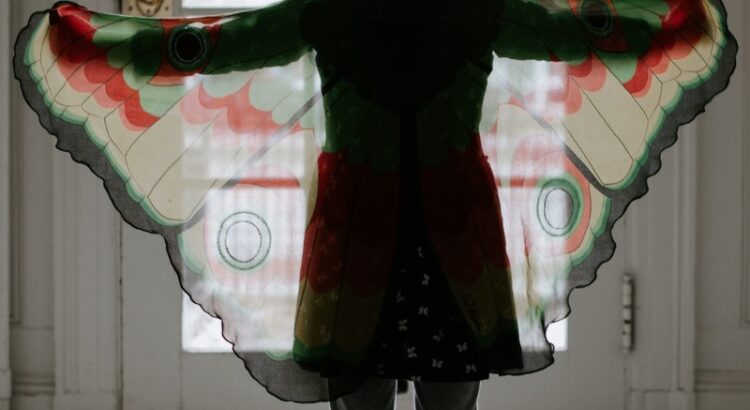How to Encourage Creative Play
Preschoolers, as you may have noticed, enjoy playing. According to experts, not all play is created equal. Here are some open-ended” activities to encourage children to engage in creative, imaginative play. Creative Play can be divided into seven major categories. In no particular order, these are:
- Dramatic Play
- Block Play
- Outdoor Play (“large muscle play”)
- Table Play (“small motor control”)
- Art
- Music
- Books.
If you have some items in each category, then you have a complete play room. If, however, when you sort through your child’s toys, you find one category is very small or missing completely, then you have a good idea what to get for the next birthday or Christmas. Conversely, if one area is overflowing with toys, some of those could be culled.
Creative play is an important way for children to learn about their surroundings. It includes a variety of indoor and outdoor activities that rely on imagination to develop a wide range of skills. The goal of creative play is to allow children to have fun while expanding their knowledge and learning new skills.
It is critical to provide a space where children can let their imaginations run wild in order to encourage creative play activities. Children’s creative play frequently involves them replaying previous situations or events. It is extremely beneficial to have an open space to do this in.
Dramatic Play
Providing a variety of activities from which children can choose is an excellent way to encourage and increase creative and dramatic play. By designating different areas for different activities, children can gravitate toward what interests them the most.

Dramatic Play is also called “playing house”, but it is so much more than that. It includes any type of role playing, from fairy princesses, to cowboys, to firemen, to space cadets, to play-acting the part of an animal, or even a plant. Dramatic play includes playing with puppets, stuffed toys, dolls, finger puppets, dress-ups, costumes, and face paint. Every playroom should have a dramatic play area, regardless of whether you have girls or boys.
Toy kitchens can be quite an investment. Childcraft makes a hardwood kitchen ensemble – the kind found in many kindergartens and day cares – that sells for $849.00, not including shipping and tax. Toys R Us sells a smaller, one piece version that is closer to $100. If you check on Ebay, you may find something used within your budget. You could even make a temporary one out of cardboard boxes for now.
Toy kitchens, of course, need toy dishes, pots and pans. Toy food is not necessary. Most children just enjoy pretending, and adding the toy food makes more to pick up at the end of play. If you wish, you could experiment with a few plastic food toys, and watch how your child plays with them. Once in a while it is fun to add water to the toy kitchen sink, but this should be a special, only with permission, rainy day privilege, and not something your child is allowed to do regularly. You don’t want mold growing on damp toys.
Toy kitchens need baby dolls, doll clothes, dress-up clothes, purses, old adult shoes, a necktie or two, hats, and whatever else you can imagine. Most of this you can gather at Good Will or a second-hand store, or even from your own closet. Making doll clothes is not hard. If you don’t sew, ask a grandparent, godparent, or good neighbor to make them for you. For little children, make sure to use large buttons, large snaps, or large velcro spots, to make it easier for little fingers.
Finally, you can add specific play boxes to the dramatic play area, ones that you rotate from time to time. This is the greatest trick to renew interest in old toys, and to keep the playroom from becoming so overflowing with stuff that the child can’t pick it all up. Put some away! Maybe this month you bring out the duplos and the doctor play kit. Next month you put them away in a storage closet, and bring out the tonka trucks and fireman play kit. Get the idea?
Some children’s libraries even stock play kits for you to borrow at no charge! Check out your library, and if they don’t already do this, suggest they do! Our local library has over 60 simple playkits. Right now we have the Curious George one checked out. It comes with a stuffed Curious George doll, a flannel board with enough pieces to retell several stories, two books, and a list of suggested activities for the parent!
Block Play
Nothing beats a good supply of basic wooden blocks. If you have basic woodworking skills, you might be able to cut up scrap wood, smooth it out, and create your own block collection.
Entire books have been written on the importance of block play. I’m talking here about the large, hardwood blocks sometimes called “kindergarten blocks” or even “unit blocks”. These are an expensive toy, but well worth it. A good set will last through all your children and your grandchildren. You can sometimes find them on ebay. Buy the largest set your budget can afford. A 110 piece set at around $140 costs less than a computer or even a playstation, yet will provide a greater benefit to your child.
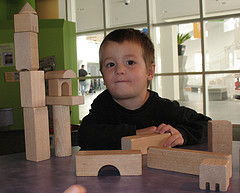 When a child decides what to build with blocks, he is developing his creativity and problem solving skills. As he builds, he learns about shape, size, balance, structure, and form. When he discovers that two square blocks equal the length of one unit block, he is learning about math. He can count blocks, match them, sort them, group them, stack them and knock them down. If you talk with him when he plays blocks, you can teach him words like “half”, “whole” and “gravity.”
When a child decides what to build with blocks, he is developing his creativity and problem solving skills. As he builds, he learns about shape, size, balance, structure, and form. When he discovers that two square blocks equal the length of one unit block, he is learning about math. He can count blocks, match them, sort them, group them, stack them and knock them down. If you talk with him when he plays blocks, you can teach him words like “half”, “whole” and “gravity.”
When two or more children play with blocks, they develop social skills. They work together to create a whole, or they cooperate in the division of the blocks to build separate structures. They develop language skills as they communicate with each other.
Picking up, stacking, moving, sorting blocks develops large and small muscle control, and eye-hand coordination – all necessary skills before the child can learn to write his ABCs.
Unit blocks are so called because the basic shape or unit is a standard size, 5 1/2 inches by 2 3/4 inches by 1 3/8 inch. The half unit is 2 3/4 inches square. The double unit is 11 inches long, and the quad unit is 22 inches long. No matter where you buy your unit blocks, they should always be this size. Look for a good hard wood, fine sanding, and rounded corners.
Building toys like LEGO® can also inspire creative construction. Instead of “build it this way” kits, search sale prices for open-ended LEGO® collections.
Outdoor Play
This area of play includes riding tricycles, digging in a sand box, splashing water, throwing balls, climbing trees, jumping on a mattress or small trampoline, turning summersaults, climbing ropes, swinging, sliding, and anything else your child can do while outside. Finding ways to do these “outdoor” activities inside, especially on a rainy day, can be a bit more tricky. For very young children, you can buy a small indoor slide. I once had a neat jumping toy that was a canvas cover over an inflated inner tube. My toddlers loved it, but it was a bit hard to store when space was limited. Water play, of course, can be done in the bathtub.
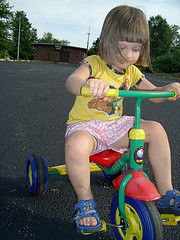 Your child needs a place to play outside every day. He or she needs to be able to use an outside voice – and be taught the difference between outside and inside voices. If you have a backyard, perfect! If you live in an apartment, you’ll need to find a place to walk to every day, twice a day. Two hours outside is not that long. It can be divided up into an hour in the morning and an hour in the afternoon.
Your child needs a place to play outside every day. He or she needs to be able to use an outside voice – and be taught the difference between outside and inside voices. If you have a backyard, perfect! If you live in an apartment, you’ll need to find a place to walk to every day, twice a day. Two hours outside is not that long. It can be divided up into an hour in the morning and an hour in the afternoon.
In a later post, I can suggest ways to design the play yard, but for now, list what your child already has, and what you could add to the pile. A good tricycle is around $70, is made of steel and will last a lifetime. Plastic trikes are not very satisfactory. Check rummage sales, yard sales, ebay, and auctions if spending the money on a good trike is not in your budget. Trikes are better than bicycles, too. They are sturdier, less prone to tipping, and the child can trail a wagon behind him.
Table Play
These are the games with pieces that can be lost, including Bingo, Candleland and Memory games. Stringing beads, lacing cards, nesting blocks, and puzzles are better played at the table, so the pieces do not get lost. Table games also include play that may need some adult supervision, like exploring small objects with a magnifying glass.
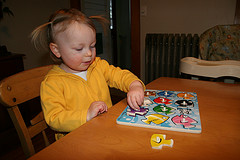 For a very young child, keep these toys out of reach, and set them on the kitchen table when you have to be in the kitchen anyway. The child can play with something new, while being near you, and you can supervise. As your child gets older, you might still keep these toys in the kitchen, but perhaps move them to a low cupboard so the child can help himself.
For a very young child, keep these toys out of reach, and set them on the kitchen table when you have to be in the kitchen anyway. The child can play with something new, while being near you, and you can supervise. As your child gets older, you might still keep these toys in the kitchen, but perhaps move them to a low cupboard so the child can help himself.
Table play is important mostly for developing small motor control. Learning to manipulate small objects and improving dexterity are important skills so the child can later hold a pencil correctly and learn to write. Learning to put together puzzles helps develop spatial awareness. Children who do puzzles well tend to be good at math.
Art
For the home, art activities are often best done at the kitchen table as well, but they are different from Table Play in one very important distinction. There are no right and wrong ways to do art! There is only one way to do a puzzle. There is only one winner in Candyland. But art is a process. It is self-expression. Never tell your child what to paint, or that he painted something wrong! (Unless he painted the kitchen blue – see Cradle & Crib for more about that!)
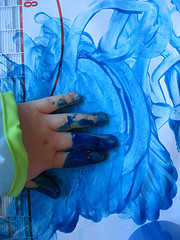 Art materials are one of the cheapest toys you can add to the playroom, but you will be replacing them again and again, as they get consumed. You will need drawing paper, crayons, markers, pencils, scissors, paint, thicker paper for painting on, construction paper, paste, glue, glitter, a scrapbox with assorted items for collage making, like yarn bits, cotton balls, paper scraps, tissue paper, wrapping paper, paper bags, etc., and clay, and cardboard, and posterboard, and whatever else you can think to add.
Art materials are one of the cheapest toys you can add to the playroom, but you will be replacing them again and again, as they get consumed. You will need drawing paper, crayons, markers, pencils, scissors, paint, thicker paper for painting on, construction paper, paste, glue, glitter, a scrapbox with assorted items for collage making, like yarn bits, cotton balls, paper scraps, tissue paper, wrapping paper, paper bags, etc., and clay, and cardboard, and posterboard, and whatever else you can think to add.
All children need crayons! If you could have only one toy, it should be crayons! I am continually astonished at the number of homes I see that don’t allow crayons! The parent usually says something about not wanting the child to color on the walls. Well, guess what? Crayons wash off. And you can teach your child not to color on the walls. We don’t forbid our children to have roller skates because we’re afraid they will wear them in the house. We don’t forbid our children to have watches because we’re afraid they’ll flush them down the toilet. We don’t even forbid our child to have a toothbrush because we’re afraid he will stuff it up his nose! We teach our children the right way to use a toy or a tool, and then we enforce the rules.
That said, it’s okay to keep crayons out of reach, and only let a younger child use them while being supervised. And crayons really do wash off just about everything.
Save your child’s art work. Display it proudly. Mail it to a grandparent, or an adopted grandparent in a nursing home. Or send it to your pediatrician, your dentist’s office, or even your pastor. They can always throw it out later, but most will display it at least for a while. Imagine how great your child will feel when he sees something he created framed and hung in his doctor’s office the next time he visits!
Music
To encourage children to explore music, create a collection of simple instruments (tambourines, drums, xylophones, etc.). If you play an instrument, invite them to join you in a free-form improv session.
Music should be part of your child’s world, but so should silence. Don’t play a radio all the time, which may teach your child to “tune out” and ignore you! The music area of the playroom could include some toy instruments. Rhythm band toys are very inexpensive, often under $20, and include tambourines, shakers, a drum, bells, triangle, and maybe a swirly scarf to wave in the air while marching to music.
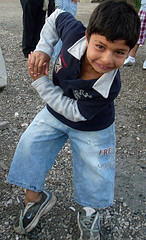 If your child takes music lessons, that’s great! Suzuki is a great program, and I’ll devote a separate post to that alone. But generally the small violin, which costs upwards of $400, is kept out of reach except when the child is practicing under adult supervision, and with good reason! So having small, toy musical instruments available to the child is still important.
If your child takes music lessons, that’s great! Suzuki is a great program, and I’ll devote a separate post to that alone. But generally the small violin, which costs upwards of $400, is kept out of reach except when the child is practicing under adult supervision, and with good reason! So having small, toy musical instruments available to the child is still important.
The music area of the playroom could include a small, child-friendly cassette or CD player, some cassettes and CDs – with a variety of children’s songs, classical music, country, international music, and more. And most important, don’t forget to sing! Singing is cheap, readily available, and easy to do. Teach your child to sing. Sing to him often. I’ll upload some podcasts of popular children’s songs for you to learn. You do not have to have a great voice. I don’t. But I sang to my children. All of them learned to sing. Two of them went on to state with their voice solos. All of them sing in church choirs, and all of them have told me how important music is to them. Music can calm an angry spirit, encourage the discouraged, uplift the downtrodden, heal the hurting heart. For all that, how can you keep from singing?
Books
This brings us to the last “toy” category in the playroom. Books aren’t really toys. They are like best friends. Don’t buy only expensive picture books that you keep on a shelf out of the child’s reach. These are lovely, and should certainly be part of the reading home, taken down at special times and shared with the child. But your child should have regular access to a wide variety of books. Board books, picture books, easy readers, read-aloud books. Even a couple of “gimmicky” books – the ones with flaps that open or tabs that pull out – are okay. But limit the gimmicky ones, as they cost more and don’t last long. Teach your child to respect books, but allow your child to use them. Love them. Wear them out. A child who loves the written word is more likely to pay attention when being taught to read.
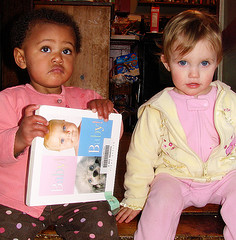 So that’s it. That’s a complete guide to everything you need in your child’s play area. If you toured a really good quality day care, you would see the block corner, the book corner, the art corner, the dramatic play area, and more. Your “corners” may not be all in the same room. You may have to have the art corner and the table toys in the kitchen, the large muscle toys in the garage and back yard, and the dramatic play stuff in an empty closet or spare bedroom. But the important part is that you plan for play in these seven categories, and encourage your child to play there. The lesson plans I create will be based on these areas of play.
So that’s it. That’s a complete guide to everything you need in your child’s play area. If you toured a really good quality day care, you would see the block corner, the book corner, the art corner, the dramatic play area, and more. Your “corners” may not be all in the same room. You may have to have the art corner and the table toys in the kitchen, the large muscle toys in the garage and back yard, and the dramatic play stuff in an empty closet or spare bedroom. But the important part is that you plan for play in these seven categories, and encourage your child to play there. The lesson plans I create will be based on these areas of play.
